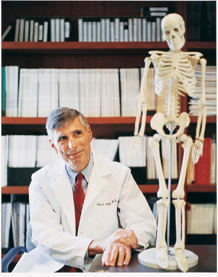Dear Friends and Colleagues,
Leslie Williamson |
|
 |
|
During my career as a physician — and pediatrician — research has led to great improvements in the treatment of childhood illnesses in this country. More than 80 percent of children diagnosed with cancer survive; four decades ago it was virtually incurable. Vaccines have eliminated major causes of meningitis, therapies have nearly stopped the transmission of HIV from mother to child, and surgical advances have led to life-saving treatments for heart disease and numerous other childhood disorders.
Despite these and other advances, the state of health for America’s children is shocking. One in eight U.S. children have no health insurance —that’s 9 million children. One in eight U.S. children are born prematurely. And despite our country’s wealth and medical sophistication, the infant mortality rate recently surpassed Cuba’s, placing it at the bottom of a list of 27 industrialized countries. In fact, the only way we lead the world is in the proportion of health-care dollars consumed as administrative overhead!
Everyone, not just pediatricians, should be upset about this. Poverty and illness that begin during youth are leading to an infirm (and expensive) future for this nation. Look at the numbers. Between 13 and 23 percent of our young live with chronic conditions such as asthma or diabetes, 20 percent struggle with mental health problems such as depression, eating disorders and attention deficit/hyperactivity, and 14 percent are overweight or obese, with the number increasing each year. For the first time, average life expectancy in the United States may be decreasing — a result of rising childhood obesity.
The impact of these diseases on children and adolescents — and their impact on our entire health-care system — is enormous. What’s the answer? To be sure, universal health care for children would solve many of the problems facing children’s health. But not all.
Pediatrics is currently, and increasingly, suffering a workforce shortage. The percentage of medical graduates who become pediatricians has decreased by almost half over the past decade: 11 percent in 1995 compared with 6 percent in 2005. Perhaps even more problematic is that fewer choose pediatric subspecialty training. This is particularly pronounced in certain areas — pediatric neurology and pulmonary medicine to name two — and is already resulting in shortages of clinical care providers.
Moreover, we are witnessing a paucity of pediatricians pursuing careers in research. Unfortunately, we run the risk of a serious shortfall of pediatric researchers at a time when science is bringing forth some of the most exciting opportunities of our lifetimes. Thus, we may miss out on opportunities to translate these advances into treatments for children.
This is one area where Stanford can make an important difference. Through our medical school’s support for students to engage in research, we are building the corps of physician-scientists for the future.
Though challenging, a pediatrician’s work is extraordinarily satisfying. It’s a joy to practice medicine at Lucile Packard Children’s Hospital, which is truly an oasis for children and their families.
But with U.S. children’s health threatening to take a turn for the worse, it’s clear we have to do a better job of focusing the attention of policymakers and the public on the existing needs and problems. This Stanford Medicine special report identifies some critical issues in pediatric care. As always, I hope you’ll be moved to take action and advocate for kids.
With best regards,
Philip A. Pizzo, MD
Professor of Pediatrics and of Microbiology and Immunology
Carl and Elizabeth Naumann Professor
Dean, Stanford University School of Medicine

